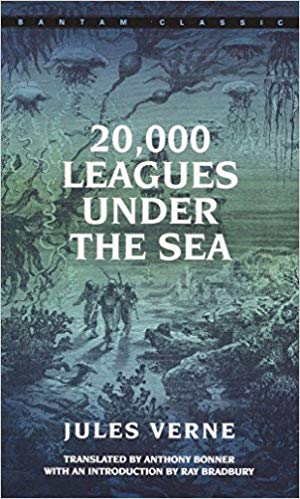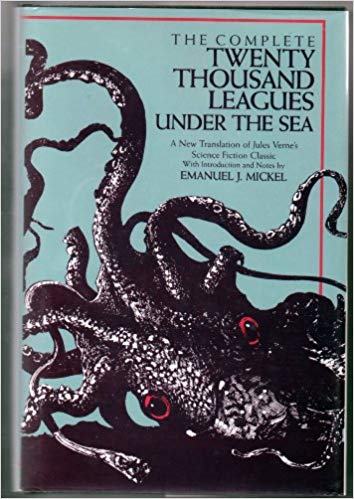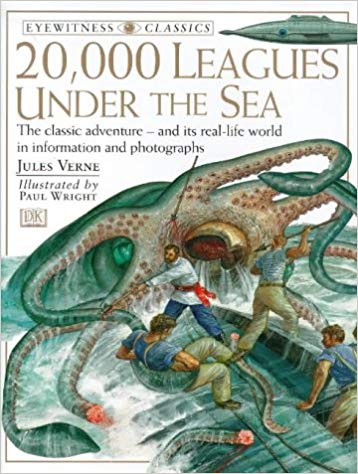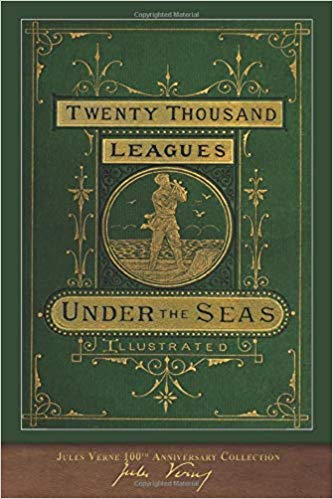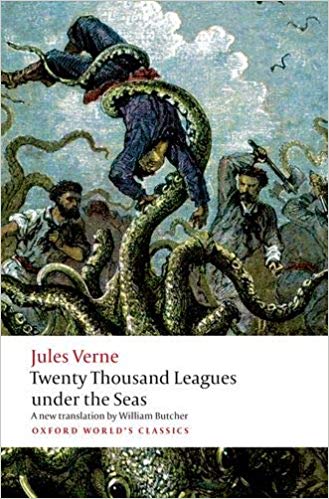If you’re a really good author, your book’s reputation can survive even a botched translation. As evidence, I offer the first English language translation of Jules Verne’s 20,000 Leagues Under the Sea.
Before we get to that, I’ll remind you of an upcoming anthology I’m co-editing, along with the talented and creative Kelly A. Harmon. We both encourage you to contribute a short story to 20,000 Leagues Remembered, our sesquicentennial tribute to Verne’s novel. You can find more information about that here.
The success of Verne’s undersea masterpiece in France prompted its translation into several other languages. As bad luck would have it, the first translation into English got rendered in 1872 by Lewis Page Mercier, a Protestant Reverend in London.
Among his many translation errors are the following:
- Sea or Seas? Mercier should have translated the novel’s title as “…Under the Seas” (plural). Note how that one little ‘s’ could have spared countless mix-ups between vertical depth and horizontal distance. You can’t go 20,000 leagues (43,000 miles) deep into one sea, but a plural ‘seas’ clarifies the meaning.
- Disagreeable Territory. Verne knew his geography and wrote about his character Pierre Arronax returning from the Badlands of Nebraska. In one of his worst howlers, Mercier rendered the Badlands as “the disagreeable territory of Nebraska.” In other words, the phrase survived the English-to-French translation, but couldn’t quite make it back the other way.
- Lightweight Steel. Mercier translated some dialogue of Captain Nemo as “These two hulls are composed of steel plates, whose density is from .7 to .8 that of water.” If Nemo had discovered a type of steel that could float like wood, it would be worth more than that casual mention. Of course, Verne wrote “whose density is 7.8 times that of water.”
- Cork Jackets. When the (Mercier-translated) Nemo asked Arronax if he’d like to don his cork jacket, he didn’t mean a garment woven in Cork, Ireland nor a coat made from tree bark. Verne’s words should have come out as ‘diving suit.’
- From Where to Where? Mercier translated the title of Part II, Chapter XX as “From Latitude 47° 24′ to Longitude 17° 28′.” Wait…from a latitude to a longitude? For all its numerical precision, that title tells you nothing about the path of the Nautilus. A competent translator would have rendered it as “In Latitude…and Longitude…”
These are only a few of the atrocities Mercier committed against Verne’s text. For example, he left 20-25% of the novel untranslated. Perhaps these were the parts he considered the dullest.
Perpetuating Mercier’s many errors, subsequent English editions of the novel used his translation. Up until the 1970s, his was the most widely available. When I first read 20,000 Leagues, I read a Mercier.
As pathetic a hatchet-job as Mercier’s translation was, the innate greatness of Verne still shone through. When a bad version is all you have, you pause only a second to wonder at the odd phrasings and logic flaws, then read on. I wish I knew French and could read the novel in its original tongue.
Fortunately, today’s English readers have several good translations from which to choose, including the following:
Translator: Anthony Bonner; Publisher: Bantam Press (1985)
Translator: Imanuel J. Mickel; Publisher: Indiana University Press (1992)
Translators: Walter James Miller and Frederick Paul Walter; Publisher: Naval Institute Press (1993)
Translator: Ron Miller; Publisher: Penguin Books (1998)
Translator: Frederick Paul Walter; Publisher: SeaWolf Press (2018)
Translator: William Butcher; Publisher: Oxford University Press (2019)
While writing your own story inspired by Verne’s classic and preparing it for submission to 20,000 Leagues Remembered, consider re-reading the original work. Avoid any version translated by Mercier, and read one of the newer ones recommended by—
Poseidon’s Scribe

